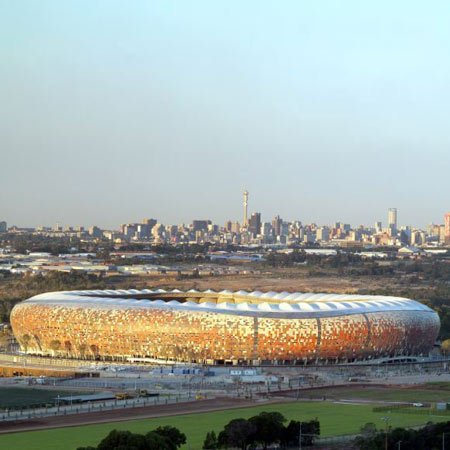
Soccer City by Boogertman Urban Edge + Partners and Populous
Soccer City in Johannesburg, reconstructed by architects Boogertman Urban Edge + Partners and global sports architecture firm Populous, will host the final of the FIFA World Cup, which starts next month.
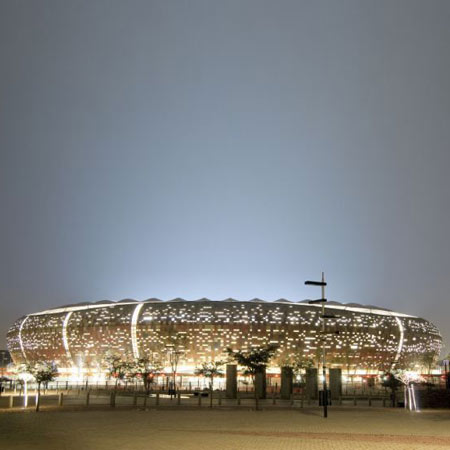
The design of the 88,460-capacity stadium is based on an African pot known as a calabash.
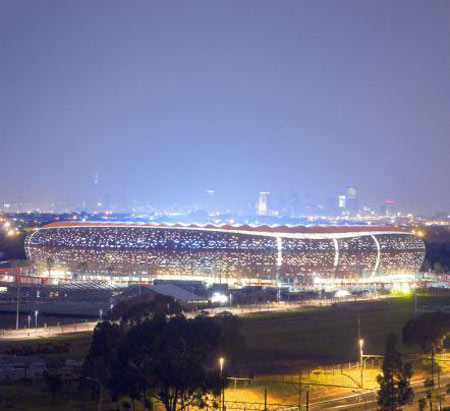
The stadium's curvilinear façade is made up of laminated fibre-reinforced concrete panels in eight different colours and two textures, and its surface is punctured by a series of open and glazed panels.
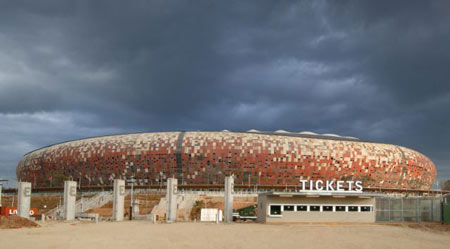
Soccer City has been rebuilt around the existing structural profiles of the previous stadium built in the mid 1980s and envelopes the upgraded triple-tiered seating bowl.
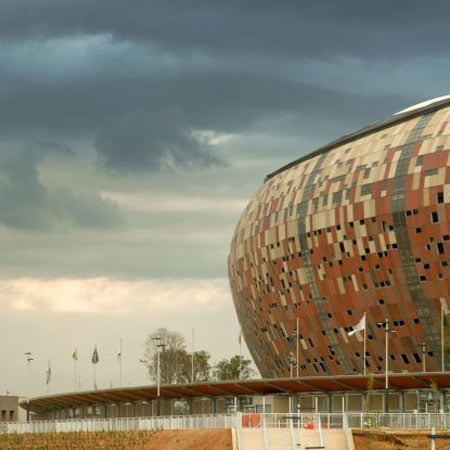
Here's some more information from the architects:
Soccer City by BOOGERTMAN URBAN EDGE + PARTNERS in partnership with POPULUS
By 2010, 80 000 cubic metres of concrete will have been poured, 9000 tons of reinforcing steel would have been placed and 8000 tons of structural steel will have been erected.
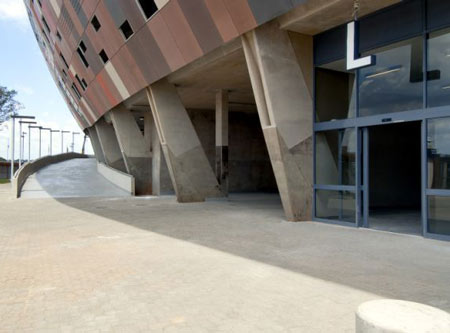
This, in combination with the moving of approximately 120 000 cubic metres of soil, fine architecture and dedicated efforts in the design offices and on site, will result in Soccer City being transformed into one of the most striking, impressive and well-equipped stadiums in the world.
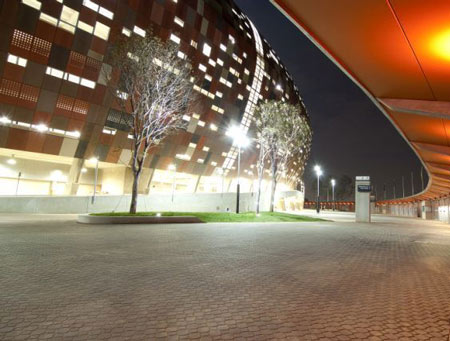
The ±90 000 seater venue will host both the opening match and the final of the 2010 FIFA World Cup. The existing structural concrete profile of the two suite levels and upper tier were extended all round to encircle the pitch.
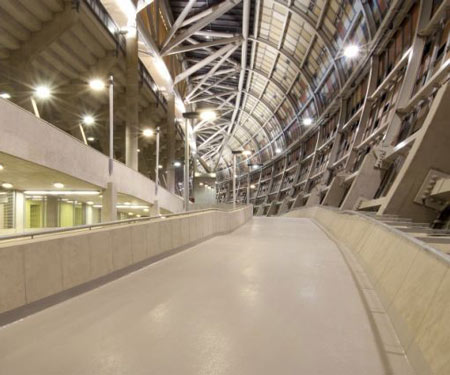
The existing lower embankment was rebuilt in insitu off-shutter concrete to vastly improve the view lines and comfort of the most popular seats in the house. The upper third of the existing embankment was raised to form a secondary tier on new concrete rakers and pre-cast concrete steppings.

The upper embankment and the rebuilt lower embankment are accessible from the lower concourse, which is fed from the podium level. The two suite levels and the upper tier are accessed via 3-dimensional concrete ramp structures that are contained within the façade of the pot. The suite levels also have separate lift and stair lobbies at each corner for secure VIP access.
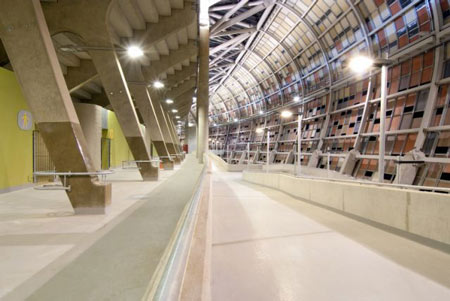
The pot’s façade is made up of fibre reinforced concrete panels, in a selection of 8 colours and 2 textures that reference the shades and textures of the calabash. The pot is punctured by open or glazed panels that suggest pattern on the façade, which comes into its own when the inside volumes are illuminated. The façade is articulated by 10 vertical slots which are aligned geographically with the 9 other 2010 stadia as well as the Berlin stadium. They are - representative of the road to the final.
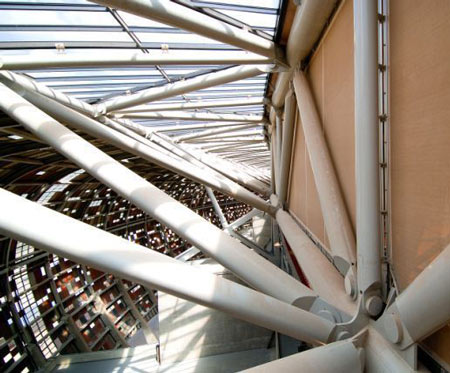
The calabash façade is supported by inclined off shutter 3 dimensional curved concrete columns which have a horizontal eccentricity of 6.5m in relation to its base. The upper roof, which is cantilevered from an enormous triangular spatial ring truss, is covered by a PTFE membrane in a colour similar to that of mine-dump sand. The bottom of the trusses is covered by a perforated mesh membrane, thus giving the appearance of a smooth under-slung ceiling.
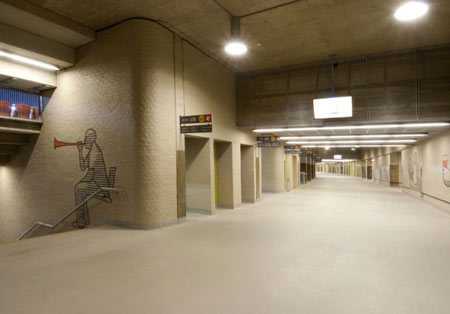
The triangular spatial ring truss is supported by twelve, 40 meter high concrete shafts which are subjected to huge tension and compressive forces and consequently have piles which are anchored in the bedrock.
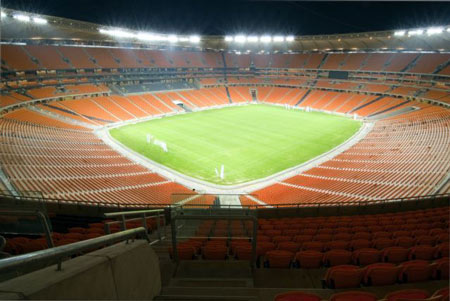
The choice of concrete for the bulk of the structure was taken to match with the existing structural profile so as to enable all pre-cast units to be made on site, and to improve on the costs and lead times of a structural steel framework.
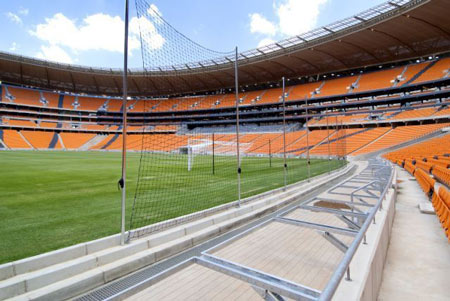
The architectural design of the stadium was selected from a series of concept designs, ranging from an acknowledgement of Jo’burg’s disappearing mine dumps; the kgotla (defined by the tree) of the African city state; the African map as a horizontal representation, which included the roof as a desert plane supported on tropical trees set within the mineral wealth of Southern African; to a representation of the protea, our national flower.
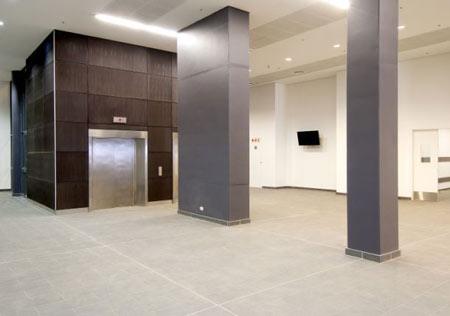
The calabash, or African pot design, proposed by Boogertman Urban Edge + Partners was selected as being the most recognisable object to represent what would automatically be associated with the African continent and not any other. The calabash, or ‘melting pot of African cultures’, sits on a raised podium, on top of which is located a ‘pit of fire’. Thus the pot sits in a depression, which is the ‘pit of fire’, as if it were being naturally fired. The pit of fire demarcates the security and turnstile line separating the outer areas and the secure inner areas.
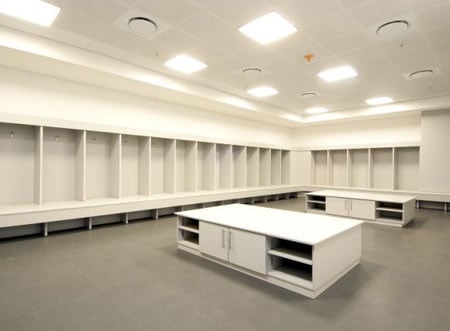
The structural profile of the existing suite levels and upper-tier seating of the existing western grandstand were extended all round to encircle the pitch. The existing lower embankments were rebuilt to vastly improve the view lines and comfort of the most popular seats in the house. The upper third of the existing embankment was raised to form a secondary tier, thus turning the stadium into a 3-tiered, rather than a 2-tiered, stadium.
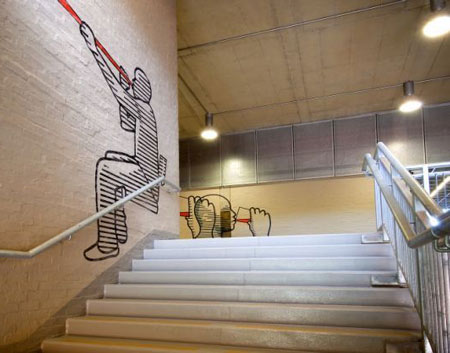
The upper embankment and the rebuilt lower embankment are accessible from the lower concourse, which is fed from the podium level. The two suite levels and the upper tier are accessed via 3-dimensional ramp structures that are contained within the façade of the pot. The suite levels also have separate lift and stair lobbies at each corner for dedicated secure VIP access.
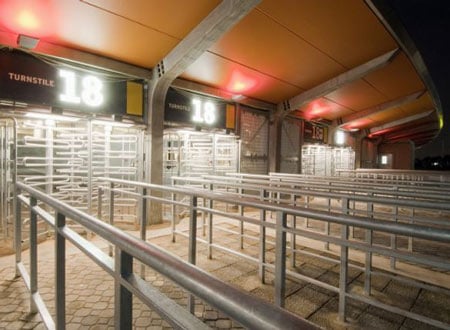
The pot’s façade is made up of laminated fibre reinforced concrete panels, in a selection of 8 colours and 2 textures that make reference to the shades and textures of the calabash. The pot is punctured by open or glazed panels which create a suggestion of pattern on the façade that comes into its own when the inside volumes are illuminated.
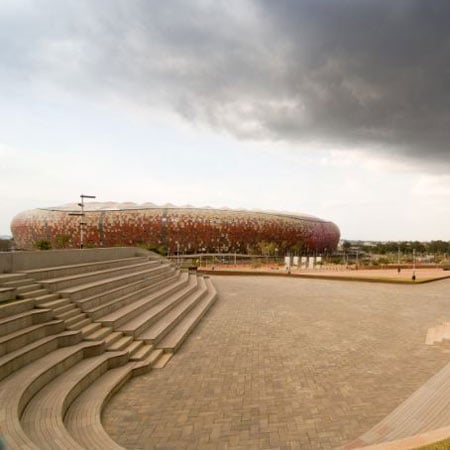
The façade is articulated by 10 vertical slots which are aligned geographically with the 9 other 2010 stadia, as well as the Berlin stadium. These are representative of the road to the final, and it is hoped that, after the World Cup, the scores of each game at each venue will be placed in pre-cast concrete panels on the podium. A visit to the stadium will thus provide one with a full history of the World Cup and all its scores.
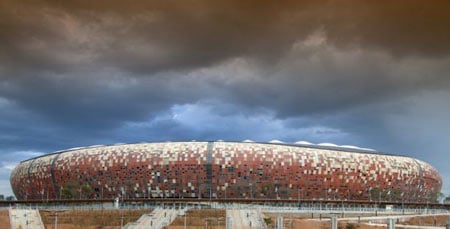
The upper roof, which is cantilevered from an enormous triangular spatial ring truss, is covered by a PTFE membrane in a colour similar to that of the adjacent mine-dump sand. The bottom of the trusses will be covered by a perforated mesh membrane, thus giving the appearance of a smooth under-slung ceiling.
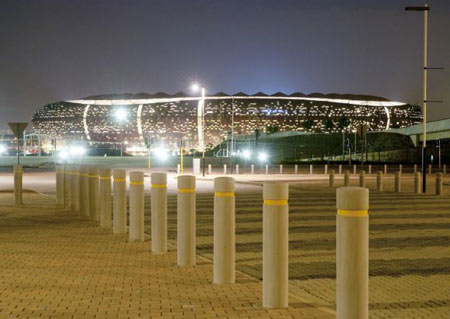
All VIP areas and the stadium management offices will be located behind the main western grandstand, with a dedicated VIP entrance. New change rooms, media work areas, auditorium, and VIP parking are located within a new basement under the podium on the western side of the stadium.
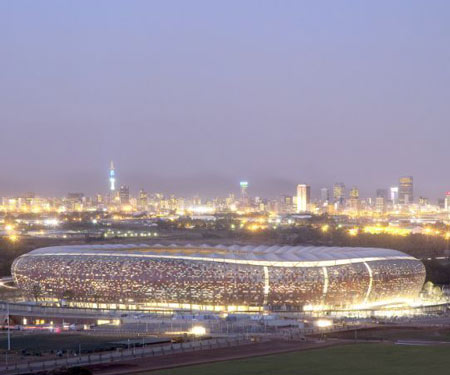
Project details
Stadium: Soccer City
City: Johannesburg
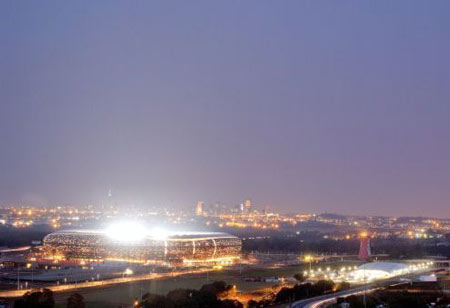
Built: 1987
Construction: major upgrade
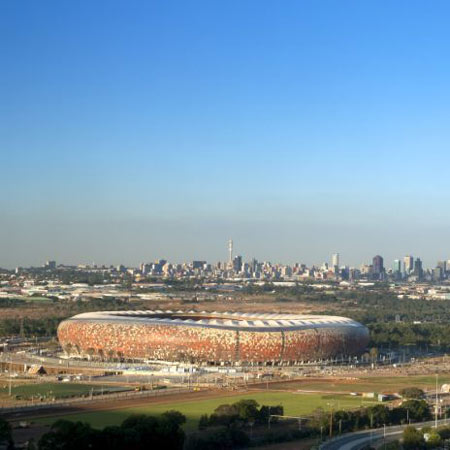
Completion: 2009
Gross Capacity: 88,460
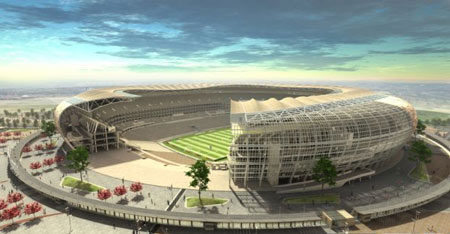
See also:
.
 |
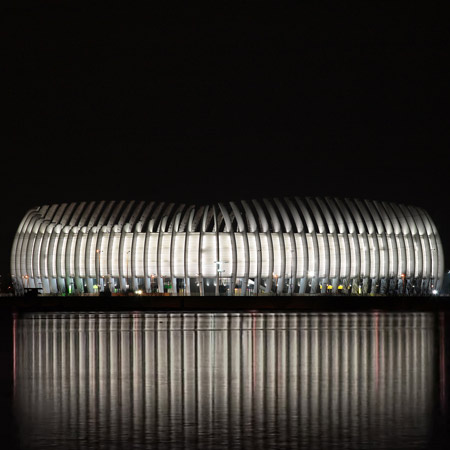 |
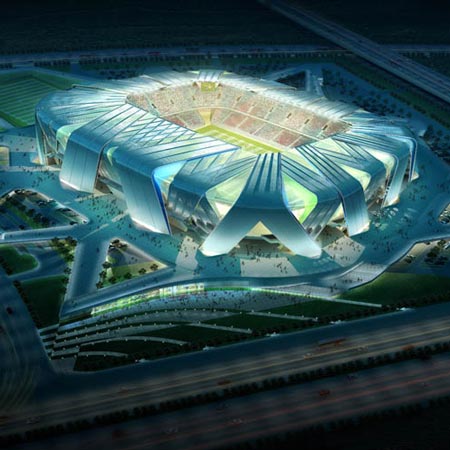 |
| London 2012 Olympics stadium by HOK Sport | Arena Zagreb by UPI-2M |
Dalian Football Stadium by UNStudio |